Blurring the Lines
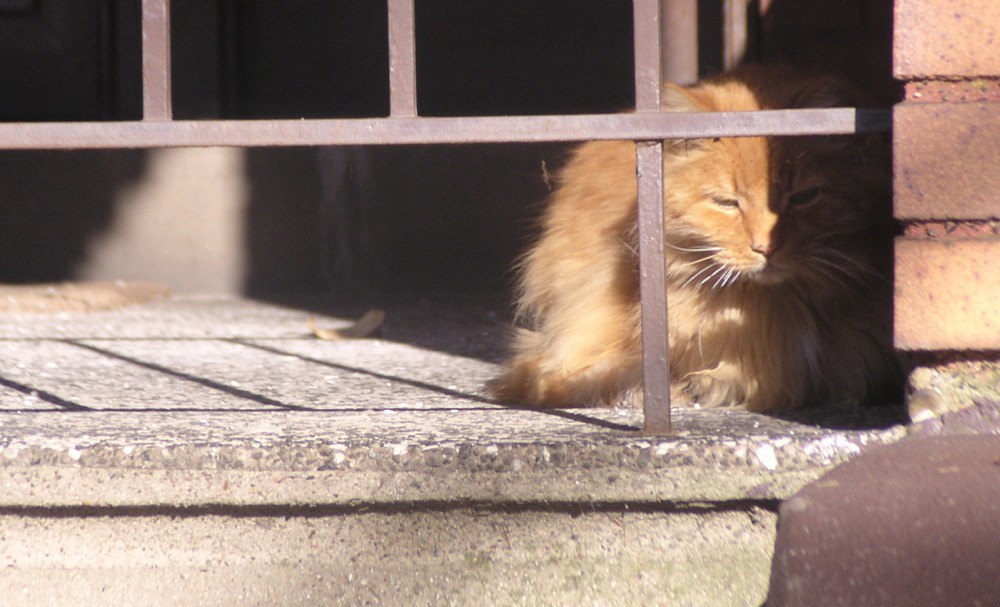
I’ve used a photo of the cat above in other posts on The Creative Cat. These posts have usually discussed the importance of spaying and neutering cats as early as possible and announced upcoming low-cost or free spay-neuter clinics especially focusing on cats who live outdoors. But how do those cats come to live outdoors, and are they somehow different from the cats who live indoors with us?
Gabby had been adopted by people who repeatedly neglected and abandoned him, and a compassionate friend who lived near repeatedly took him in for care when he needed it, had him neutered and even tried to adopt him but his “owners” made promises and took him back. In the end they moved away and left him and she found him wandering once again, ill and suffering from cancer, and assisted him through his last few months. I have so many photos of him because he was outdoors looking for a home for so long.
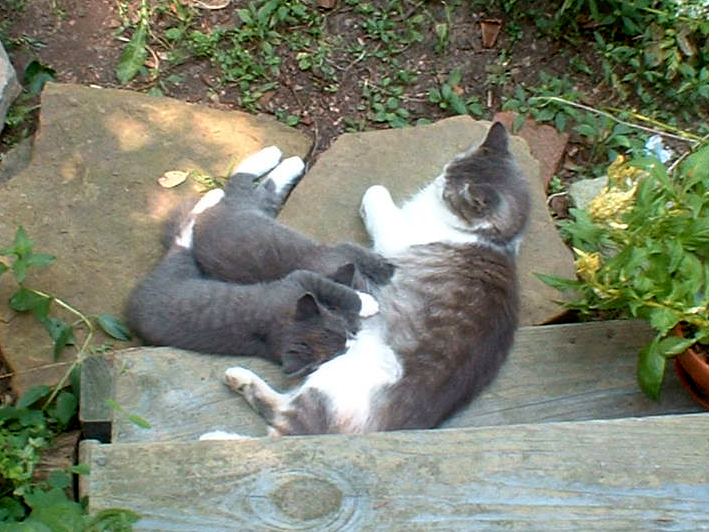
And what about those mother cats having kittens under everyone’s porches? Did they decide to run off and have a wild fling and live a Bohemian life? Hardly. They may have escaped when they’d gone into heat to answer the call of nature, though we do have a solution to that problem. Very often, however, they were abandoned by the people who’d promised to take care of them forever because they were pregnant, either when they’d found the cat was pregnant or after she’d had her kittens, taking her somewhere far enough away so she wouldn’t find her way back or simply putting her outside and not letting her back in. So her kittens are raised outside of human contact, and because they also have no responsible human to care for them, they are soon reproducing as well, if they don’t die a cruel death at the hands of nature or humans.
Just recently a cat rescuing friend reported that her elderly neighbor had died, the house had been cleaned out, and as we’ve found far too often in cases like this the cats had been tossed out like so much trash to “fend for themselves” and were now confused and frightened, and, worst of all for her, her foster capacity was overflowing and she could do nothing for them.
I will personally report that at least half the cats I rescued in my career were those left behind when people in my neighborhood moved away from their apartments, or who were tossed outside because the landlord didn’t allow pets. And even Mimi—she had an “owner” who did not get her spayed and actually paid little attention to her so that she lived mostly outdoors; I will also note that the gray and white cat Moon whose photo I’ve also used frequently “lived” at that house as well, and often brought her kittens to me herself.
Most of the cats you see on the street are not “feral” as they are so often categorized, as if they are a different breed or even species of cat, somehow less deserving of humane treatment than a cat who has a responsible owner. Cats who’ve spent even a short amount of time on the street become wary and defensive and stay that way until they feel safe again, even when a human tries to rescue them from their situation, hissing and snarling and defending themselves literally tooth and claw. Given a few days, weeks, even months, in gentle understanding hands, though, the hard shell they’ve developed will wear away and the housecat emerges once again. Rescuers laugh—“Ha! Look at this ‘feral’ cat!” as they share photos of a happily squinting cat draped over someone’s lap or completely relaxed and sleeping on its back.
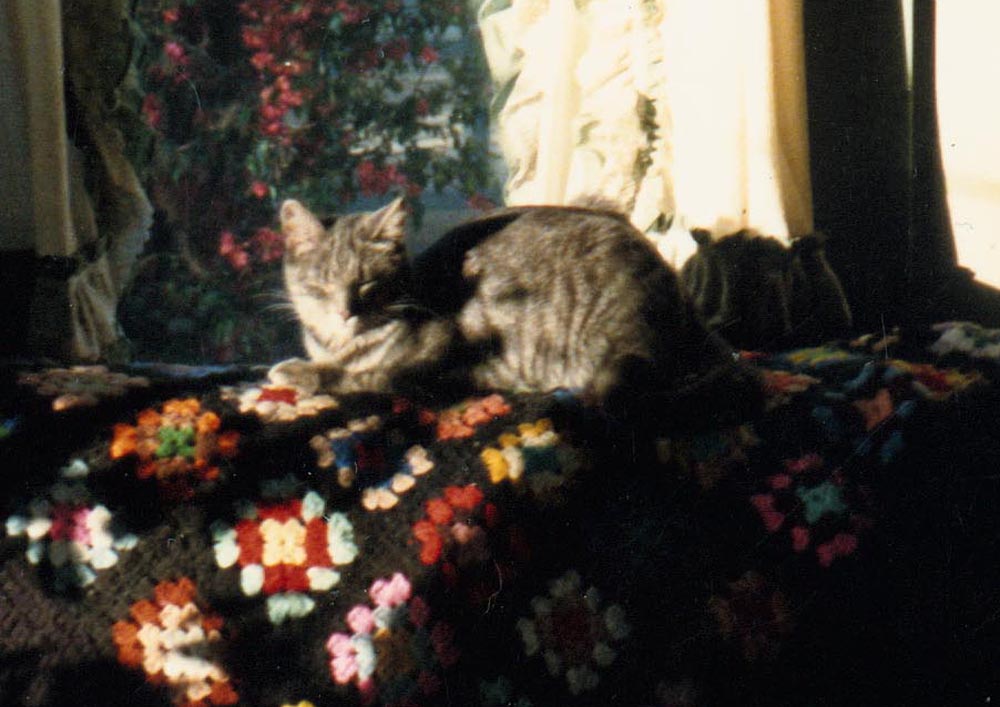
And even kittens born outside of human contact, even to a mother cat generations removed from human contact, if rescued young enough and handled by people, are immediately like any other cute, playful and friendly kittens we know. The “feral” isn’t “born into them”, it’s something created by their conditions, but their nature before “nurture” at a crucial time is truly always that of a domestic cat. And “feral” cats themselves, raised to adulthood without human contact, often learn to live with humans and even become affectionate and relaxed, like my Moses.
It’s because they are domestic cats, all of them, even the cats classed as “feral”. At last week’s seminar, “The Invisible Cat”, Risé Chontos of In Care of Cats reminded us that, “We domesticated dogs and cats first, we took them out of the woods and made them dependent on us, and now we have failed them.”
Dr. Becky Morrow of Frankies’ Friends and the Homeless Cat Management Team remarked that though HCMT had always before been focused on only cats living on the streets to keep them from reproducing, they are now expanding their mission to include all cats so that providing low-cost spay and neuter will help to reduce the numbers of cats who end up on the streets. “Now we target any cat in the community that is not spayed,” she said. And no matter the status of the cat, whether a pet or unowned or living in a managed colony outdoors, “We do whatever it takes to make life better for the kitty.” And at every clinic, all kittens and as many friendly cats as possible are not returned to the streets but are pulled from the ranks and put in foster homes, and found permanent homes.
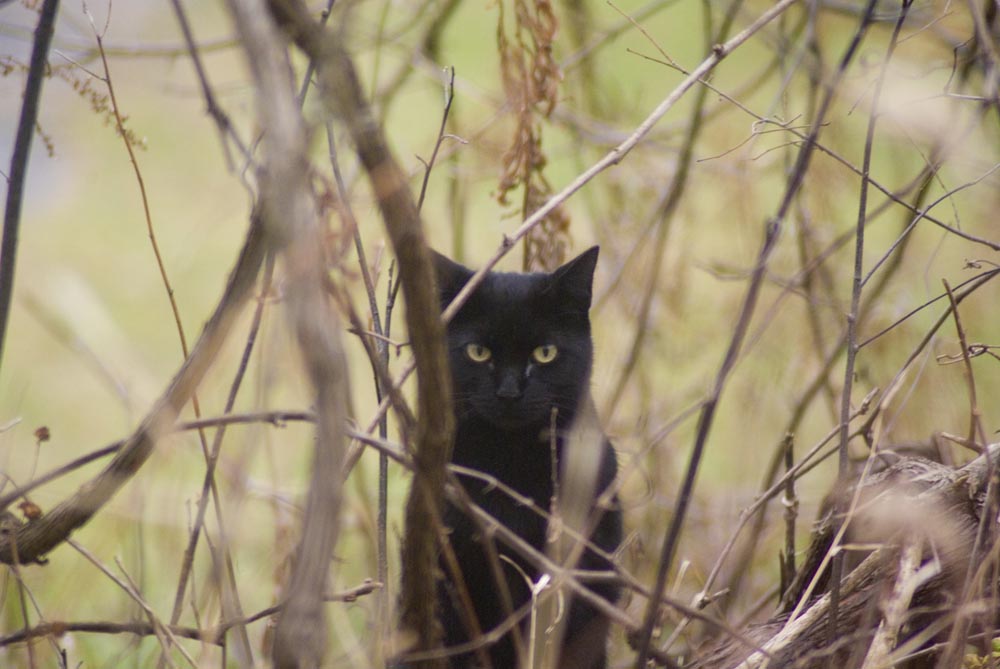
And Faith Bjalobok, professor of Philosophy who teaches the graduate-level Philosophy of Animals course and organized the seminar, told us that us that in most states abandonment of an animal is covered under state humane laws as a punishable offense. Those people who are abandoning these cats are indeed breaking the law and should be punished for it, but the laws are not enforced and in fact very few people even know they exist.
But instead of enforcing laws we already have to resolve the issue, communities all over the country are making new statutes to prevent the feeding of outdoor cats, to disband or defund TNR programs, even to trap and kill as many outdoor cats as possible to “get rid of the problem”, ostensibly for “public health and safety”.
The line gets blurred in this act as many of the cats are actually owned who are let outdoors or are escaped and can be returned, and cats who live in managed colonies are actually cared for by someone. If you’re going to “remove outdoor cats”, how do you tell which ones are not pets? To resolve this communities who promote this killing have simply said they’d kill all cats who were outdoors during a certain period.
Removing or killing cats does not solve the problem because it does not reduce the number of cats living outdoors—people continue abandoning cats because the laws we have to stop them are not enforced. It’s an irresponsible person who starts this chain of events, who adopted that cat and intentionally abandoned that cat, and yet cats are made to suffer for this as if they are the ones who had broken the law.
So we are blurring the lines on both ends of the treatment of cats who live outdoors, on one end that all cats deserve the same care and affection regardless of their living conditions and on the other that any cat who is simply outdoors deserves to die. But if we pay attention to our humane laws, it’s pretty clear where the line is drawn.
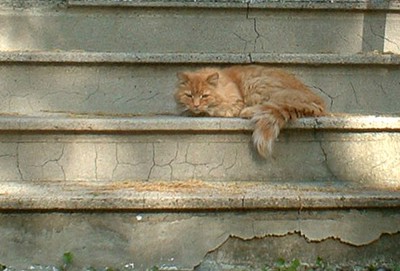
Gabby, mentioned above, in all his years on the streets did not “revert to the wild”. What was Gabby’s status? When he was in an adoptive relationship with a human he was neglected and abandoned, yet when he was a homeless cat he was given compassionate care by a human who was technically not responsible for him. In his life he was, by turns, a stray cat, considered a feral cat, a homeless cat, a rescued cat, a fostered cat, a shelter cat, a community cat, a neighborhood cat, an owned cat, an unowned cat, an outdoor cat and an indoor cat, all based on his relationship with humans. But Gabby was really only one thing all that time. Gabby was simply a cat.
. . . . . . .
Thanks to those cat rescuers who spent the last few days trapping cats for today’s HCMT clinic, for those who will take the kittens and friendly cats home to foster and care for, and those who will take their colony cats home and ensure them the best life possible with food and shelter in a protected environment, to the individuals who volunteer to work the clinic from start to finish and to the veterinarians who volunteer their time and skill because they know this helps ensure the best quality of life for all cats.
Browse some rescued cats and kittens!
All images used on this site are copyrighted to Bernadette E. Kazmarski unless otherwise noted and may not be used without my written permission. Please ask if you are interested in using one in a print or internet publication. If you are interested in purchasing a print of this image or a product including this image, check my Etsy shop or Fine Art America profile to see if I have it available already. If you don’t find it there, visit Ordering Custom Artwork for more information on a custom greeting card, print or other item.



What a wonderful post. As someone who works with a rescue that started out doing TNR only to discover so many cat that weren’t unsocialized, I know what you are talking about. That being said, two of my current fosters came here when someone went to the trouble to get new cats and then put them outside with no food or shelter. Until people are forced to be responsible (and I have no idea how to do that), community cats will continue to be out there. And I can’t tell you the number of people I have had a chance to explain TNR to when they see me bringing a cat in a live trap to our local spay/neuter clinic.
Random Felines, thanks so much for fostering all the kittens you do! I love to read about them. I also love to spread the word about spaying and neutering, and never cease to be amazed at people who don’t know. We have to figure that out, but we also have to figure out how to enforce the humane laws we have.
Hi, Bernadette, had to say how much I applaud this post.. cats out n about reproducing.. it’s not the cats’ fault.. and yet when their presence comes to the attention of people who are looking to ‘quick fix’ this problem.. for appearances sake, they choose to fix it *rse-ways on, excuse me.
Like blaming wild kids for their poor parenting. Illiteracy n innumeracy on inattention not overcrowding, obesity on over-indulgence, not dispair.
To effectively correct many situations, this one included, attention is best placed on the cause.. not solely on the effect.. or, apart from anything else.. nothing will, effectively, be changed. In this case, the cat population will re-grow.. in no time at all.. n all those savage deaths will have been for nothing.. which is not only appalling and immoral in and of itself, it’s, also, a typical short-sighted management technique based on appearances, often by officials, who have short terms of office.. n who’s only concern is re-election. Appalling levels of wrong-thinking are being accepted.. promoted, even.. nation- and world- wide.. n across the board.. in the name of the pretentious vauntings of a few.
Annie, exactly! I don’t know what your humane laws are like in the UK, but ours are pretty uneven across the board, and not surprisingly we won’t pass anything meaningful that will help the situation. People just need to be RESPONSIBLE, but that can’t be legislated, society has to change to support it.
The solution is clear fine those who abandon animals 1,000, require outside feeders to be part of a TNR program, and create community councils to address complaints about invisible cats coming on people’s property. Some day our elected officials will become as enlightened as the ancient Greek mathematician Pythagoras and realize cruelty to animals is a serious offense and leads to cruelty to humans or as Kant realized in the 18th century empathy towards animals is a prerequisite to being a moral person. I am so tired of all the killing. We are a culture of irresponsibility who settles all our problems with violence. That is not a description of a just society. Time for America to become enlightened.
Faith, it actually shocks me when we actually have the solutions in place right now, and people who are willing to support those solutions, but those in power choose the solutions based on power–eradication, violence and domination, and that’s not just over cats. But even in working with abandoned cats we are becoming just as polarized as we are politically.
We really need to inform people of the laws too, even at the time of adoption, so they know the consequences.
I hate to think about all the struggles Gabby must have faced. How sad it is that humans can abandon creatures who are dependent upon them.